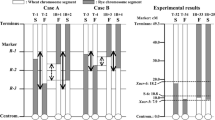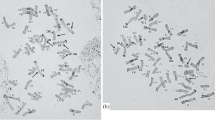Abstract
The problems of fertility restoration in the progeny of barley-wheat hybrids (H. vulgare × T. aestivum) are explained by incompatibility between the cytoplasm of cultivated barley and the nuclear genome of common wheat. Appropriate models for studying these problems are alloplasmic lines that combine the cytoplasm of barley and the nuclear genome of wheat. In this work, the differences of fertility restoration in alloplasmic common wheat lines (H. vulgare)-T. aestivum were studied depending on the influence of wheat varieties Saratovskaya 29 (Sar29) and Pyrotrix 28 (Pyr28) used to produce these lines. The alloplasmic lines were created using hybrids between the 48-chromosome offspring (Amph1) of the barley-wheat amphiploid H. vulgare (ya-319) × T. aestivum (Sar29) and these wheat varieties. Backcrossing of the Amph1 (2n = 48) × Sar29 hybrid with the wheat variety Sar29 resulted in the complete sterility in the (H. vulgare)-Sar29 line, which suggests the incompatibility of the nuclear genome of the common wheat variety Sar29 with the cytoplasm of H. vulgare. Crossing of Amph1 (2n = 48) with Pyr28 resulted in the restoration of self-fertility in the hybrid with 2n = 44. In the alloplasmic lines (2n = 42) formed based on plants of the self-fertilized generations of this hybrid, the barley chromosomes were eliminated, and recombination between the nuclear genomes of the parental wheat varieties Sar29 and Pyr28 took place. Alloplasmic recombinant lines (H. vulgare)-T. aestivum with different levels of fertility were isolated. As was shown by the SSR analysis, differences in the fertility between these lines are determined by differences in the content of the genetic material from the wheat varieties Sar29 and Pyr28. The complete restoration of fertility in these alloplasmic recombinant lines is accompanied by the formation of a nuclear genome in which the genetic material of Pyr28 significantly prevails. The conclusion is made that the common wheat variety Pyrotrix 28 is a carrier of a gene (or genes), which determines the restoration of common wheat fertility on the cytoplasm of cultivated barley.
Similar content being viewed by others
References
Surikov, I.M., Kissel’, N.I., and Orlova, I.N., Cytogenetic Characteristics of Hybrids between Barley (Hordeum vulgare L.) and Wheat (Triticum aestivum) and (T. timopheevi) Zhuk., Genetika (Moscow), 1986, vol. 22, pp. 290–295.
Islam, A.K.M.R and Shepherd, K.W, Incorporation of Barley Chromosomes into Wheat, Biotechnology in Agriculture and Forestry, vol. 13: Wheat, Bajaj, Y.P.S., Ed., Berlin: Springer-Verlag, 1990, pp. 128–151.
Zou, H., Wu, Y., Liu, H., et al., Development and Identification of Wheat-Barley 2H Chromosome Translocation Lines Carrying the Isa Gene, Plant Breed., 2012, vol. 131, pp. 69–74.
Kruse, A., Hordeum × Triticum Hybrids, Hereditas, 1973, vol. 73, pp. 157–161.
Molnar-Lang, M., Novotny, C., Linc, G., and Nagy, E.D., Changes in the Meiotic Pairing of a Wheat-Barley Hybrid Maintained for Long Term in Tissue Culture, and Tracing the Barley Chromatin in the Progeny Using GISH and SSR Markers, Plant Breed., 2005, vol. 124, pp. 247–252.
Islam, A.K.M.R., Shepherd, K.W., and Sparrow, D.H.B., Isolation and Characterization of Euplasmic Wheat-Barley Chromosome Addition Lines, Heredity, 1981, vol. 46, no. 2, pp. 161–174.
Koba, T., Takumi, S., and Shimada, T., Isolation, Identification and Characterization of Disomic and Translocated Barley Chromosome Addition Lines of Common Wheat, Euphytica, 1997, vol. 96, pp. 289–296.
Islam, A.K.M.R. and Shepherd, K.W., Isolation of a Fertile Wheat-Barley Addition Line Carrying the Entire Barley Chromosome 1H, Euphytica, 2000, vol. 111, pp. 145–149.
Szakacs, E. and Molnar-Lang, M., Identification of New Winter Wheat-Winter Barley Addition Lines (6HS and 7H) Using Fluorescence in situ Hybridization and the Stability of the Whole “Martonvasari 9 Kr1”-“Igri” Addition Lines, Genome, 2010, vol. 53, pp. 35–44.
Islam, A.K.M.R. and Shepherd, K.W., Substituting Ability of Individual Barley Chromosomes for Wheat Chromosomes, Plant Breed., 1992, vol. 109, pp. 141–150.
Islam, A.K.M.R., Shepherd, K.W., and Sparrow, D.H.B., Addition of Individual Barley Chromosome to Wheat, Barley Genetics III (Proc. 3th Int. Barley Genet. Symp.), Garching, 1975, pp. 260–270.
Shimada, T., Koba, T., Otani, M., and Niizeki, H., Morphology, Meiosis, and in vitro Propagation of Barley-Wheat Hybrids, Barley Genetics V (Proc. 5th Int. Barley Genet. Symp.), Okayama, 1987, pp. 343–350.
Hattori, N., Kitagawa, K., Takumi, S., and Nakamura, C., Mitochondrial DNA Heteroplasmy in Wheat, Aegilops and Their Nucleus-Cytoplasm Hybrids, Genetics, 2002, vol. 160, pp. 1619–1630.
Kitagawa, K., Takumi, S., and Nakamura, C., Evidence of Paternal Transmission of Mitochondrial DNA in a Nucleus-Cytoplasm Hybrid of Timopheevi Wheat, Genes. Genet. Syst, 2002, vol. 77, pp. 243–250.
Pershina, L.A., Numerova, O.M., Belova, L.I., et al., Restoration of Fertility in Backcross Progeny of Barley-Wheat Hybrids H. vulgare L. (2n=14) T. aestivum L. (2n=42) in Relation to Wheat Genotypes Involved in Backcrosses, Russ. J. Genet., 1999, vol. 35, no. 2, pp. 176–183.
Bil’danova, L.L., Badaeva, E.D., Pershina, L.A., and Salina, E.A., Molecular Study and C-Banding of Chromosomes in Common Wheat Alloplasmic Lines Obtained from the Backcross Progeny of Barley-Wheat Hybrids Hordeum vulgare L. (2n=14) Triticum aestivum L. (2n=42) and Differing in Fertility, Russ. J. Genet., 2004, vol. 40, no. 12, pp. 1383–1391.
Aksyonova, E., Sinyavskaya, M., Danilenko, N., et al., Heteroplasmy and Paternally Oriented Shift of the Organellar DNA Composition in Barley-Wheat Hybrids during Backcrosses with Wheat Parents, Genome, 2005, vol. 48, pp. 761–769.
Sinyavskaya, M.G., Aksenova, E.A., Pershina, L.A., and Davydenko, O.G., Alterations of Chloroplast and Mitochondrial DNA at Remote Hybridization in Cereals, Vestn. VOGiS, 2005, vol. 9, no. 4, pp. 505–511.
Pershina, L.A., Numerova, O.M., Belova, L.I., et al., Fertility in Barley x Wheat Hybrids H. geniculatum All. × T. aestivum L., Their Regenerants and Hybrid Progeny of Backcrosses to T. aestivum L., Cereal Res. Commun., 1988, vol. 16, nos. 3–4, pp. 157–163.
Pershina, L.A., Numerova, O.M., Belova, L.I., and Devyatkina, E.P., Biotechnological and Cytogenetic Aspects of Producing New Wheat Genotypes Using Hybrids, Euphytica, 1998, vol. 100, nos. 1–3, pp. 239–244.
Pershina, L.A., Numerova, O.M., Belova, L.I., The Effect of the Genotypic Diversity of Hordeum vulgare L. and Triticum aestivum L. on the Crossability and Production of Partially Fertile Barley-Wheat Hybrids, Russ. J. Genet., 1998, vol. 34, no. 10, pp. 1156–1163.
Trubacheeva, N.V., Efremova, T.T., Badaeva, E.D., et al., Production of Alloplasmic and Euplasmic Wheat-Barley Ditelosomic Substitution Lines 7H1L mar(7D) and Analysis of the 18S/5S Mitochondrial Repeat in These Lines, Russ. J. Genet., 2009, vol. 45, no. 12, pp. 1438–1443.
Röder, M.S., Korzun, V., Wendehake, K., et al., A Microsatellite Map of Wheat, Genetics, 1998, vol. 149, pp. 2007–2023.
Sourdille, P., Singh, S., Cadalen, T., et al., Microsatellite-Based Deletion Bin System for the Establishment of Genetic-Physical Map Relationships in Wheat (Triticum aestivum L.), Funct. Integr. Genomics, 2004, vol. 4, pp. 12–25.
Nikot, N., Chiquet, V., Gandon, B., et al., Study of Simple Sequence Repeat (SSR) Markers from Wheat Expressed Sequence Tags (ESTs), Theor. Appl. Genet., 2004, vol. 109, pp. 800–805.
Ausubel, M.L., Brent, R.E., Kingston, R.E., et al., Current Protocols in Molecular Biology, New York: Wiley, 1987.
Tsunewaki, K., Plasmon Analysis as the Counterpart of Genome Analysis, Methods of Genome Analysis in Plant, Boca Raton: CRC Press, pp. 271–299.
Murai, K., Koba, T., and Shimada, T., Effects of Barley Chromosome on Heading Characters in Wheat-Barley Chromosome Addition Lines, Euphytica, 1997, vol. 96, pp. 281–287.
Budar, F., Touzet, P., and De Paepe, R., The Nucleo-Mitochondrial Conflict in Cytoplasmic Sterilities Revisited, Genetics, 2003, vol. 117, pp. 3–16.
Hart, G.E., Gale, M.D., and McIntosh, R.A., Linkage Maps of Triticum aestivum (Hexaploid Wheat, 2n = 42, Genomes A, B, and D) and T. tauschii (2n = 14, Genome D), Genetic Maps, O’Brien, S.J., Ed., 1993, no. 6, pp. 6.204–6.209.
Martin, A.C., Atienza, S.G., and Ramirez, V.C., Chromosome Engineering in Wheat to Restore Male Fertility in the MsH1 CMS System, Mol. Breed., 2009, vol. 24, pp. 397–408.
Asakura, N., Nakamura, C., and Ohtsuka, I., RAPD Markers Linked to the Nuclear Gene from Triticum timopheevii That Confers Compatibility with Aegilops squarrosa Cytoplasmic Durum Wheat, Genome, 1997, vol. 40, pp. 201–210.
Asakura, N., Nakamura, C., and Ohtsuka, I., A Nuclear Compatibility Gene, Ncc-tmp, of Triticum timopheevi for the Cytoplasm of Aegilops squarrosa, Genes Genet. Syst., 1997, vol. 72, pp. 71–78.
Murai, K. and Tsunewaki, K., Photoperiod-Sensitive Cytoplasmic Male Sterility in Wheat with Aegilops crassa Cytoplasm, Euphytica, 1993, vol. 67, pp. 41–48.
Murai, K. and Tsunewaki, K., Genetic Analysis on the Fertility Restoration by Triticum aestivum cv. Chinese Spring against Photoperiod-Sensitive Cytoplasmic Male Sterility, Jpn. J. Genet., 1994, vol. 69, pp. 195–202.
Author information
Authors and Affiliations
Corresponding author
Additional information
Original Russian Text © L.A. Pershina, E.P. Devyatkina, N.V. Trubacheeva, L.A. Kravtsova, O.B. Dobrovol’skaya, 2012, published in Genetika, 2012, Vol. 48, No. 12, pp. 1372–1379.
Rights and permissions
About this article
Cite this article
Pershina, L.A., Devyatkina, E.P., Trubacheeva, N.V. et al. Characterization of fertility restoration in alloplasmic lines derived from hybridization of self-fertilized offspring of barley-wheat (Hordeum vulgare L. × Triticum aestivum L.) amphiploid with common wheat varieties Saratovskaya 29 and Pyrotrix 28. Russ J Genet 48, 1184–1190 (2012). https://doi.org/10.1134/S1022795412120101
Received:
Published:
Issue Date:
DOI: https://doi.org/10.1134/S1022795412120101




